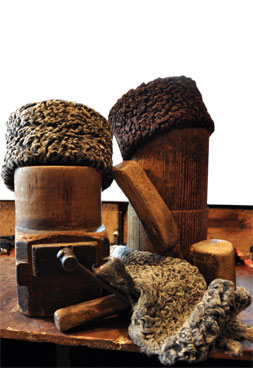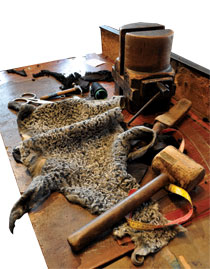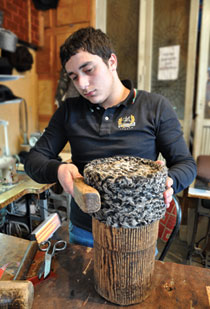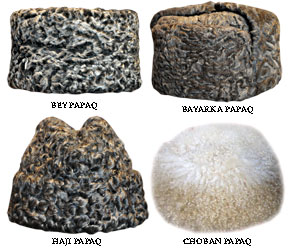 I remember from my childhood the old men sitting in the chaikhana (tea house) on hot summer days engaged in long debates. All of them wore the papaq (traditional hat) and carried worry beads. And I remember always wondering: aren’t their heads hot; why are they never without their papaqs? It came clear to me later that this headgear represented something special for Azerbaijani men. It is still special.
I remember from my childhood the old men sitting in the chaikhana (tea house) on hot summer days engaged in long debates. All of them wore the papaq (traditional hat) and carried worry beads. And I remember always wondering: aren’t their heads hot; why are they never without their papaqs? It came clear to me later that this headgear represented something special for Azerbaijani men. It is still special. A man is not a man without his papaq
Have you seen the old Azerbaijani movie Qorxma, Men Seninleyem (‘Don’t be Afraid, I’m with You’) based on events at the turn of the nineteenth and twentieth centuries?! There is an episode which reflects very well the exact attitude of the Azerbaijani man towards his papaq. Two circus artistes, the Russian San Sanich and Azerbaijani Rustam arrive in Rustam’s home village after learning of his grandmother’s illness. Although the twentieth century approaches and various innovations have appeared even here, the highlanders live by their old customs and practices.
Their adventures begin in a theatre when San Sanich, watching the play Leyli and Majnun, asks a local tough to take off his papaq. The youth, Jafar, is true to his southern temperament and ignores the request. San Sanich then takes the hat off Jafar’s head. A fight almost ensues but the local custom of hospitality forces Jafar to control himself and he decides to leave revenge for later. Why all the fuss? The papaq is regarded as a symbol of an Azerbaijani man’s dignity and honour. San Sanich was not to know that in removing the hat from Jafar’s head he was offending his honour. To lose one’s papaq was a great shame. If it were stolen then the owner knew that he had an enemy and would expect an attack to follow. ‘A man is not a man without his papaq’ goes an Azerbaijani adage.
From generation to generation
Nijat and Ramil Farzaliyev are two brothers with a small shop making and selling papaqs in the centre of Baku. There are few places in Baku selling them nowadays but this is one that has passed from generation to generation. Nijat and Ramil were taught the skill by their grandfather Nazim, whose father was also in the business. Nijat told us he has been making papaqs since he was 15. Now almost 18, he has no regrets about entering the profession.
I like it because it’s my grandfather’s business and I have to hand it on to my children as well. There are few people who can make papaqs here in Baku. And grandfather would never forgive me if I dropped his business. At first my classmates didn’t take me seriously about my profession but now their attitudes have changed. You know, this is not just my grandfather’s favourite craft; it’s also a profit-making business. I can earn my own money at my young age…
Holding the fleece of a three-day old lamb, Nijat prepares to make another papaq. It is golden-brown and will be sewn for a highly respected client, he tells us. In general, this is a hat worn by reputable men, thus its connection with honour and dignity. For our men it is as important to keep a papaq upright as it is to uphold their honour, Nijat explains. In other words, the way you treat your papaq reflects your inner values.
 Bey, Bayarka and Choban
Bey, Bayarka and Choban As we discovered, there are several types of papaq. The first and most popular is the traditional papaq called Bey papaqi which is worn by agsaggals (‘white-beards’ - respected within the community), religious leaders and young people at weddings and other festivals. It is important for this papaq to be no more than 11 centimetres high. The second has ear flaps and is called Bayarka; most often worn by military generals. And the third type is the Choban papaq; this is very popular with the foreigners who come to Azerbaijan from all over the world. It has a different structure from the Bey and Bayarka. Worn by shepherds, this papaq protects their heads against wind and snow while grazing their sheep in open fields and on steep mountain slopes. By the way, Choban in Azerbaijani means shepherd. Nijat thinks that foreigners like the Choban for its interesting shape; they buy it as a souvenir, not to wear. There are also other types of papaqs: the Seyid (descended from a holy family), Haji (someone who has been on pilgrimage to Mecca), Motal (a type of cheese, thus worn by shepherds) and others.
What is special about the papaq?
What is its main feature? - We asked Nijat. The essential part is the fleece, which should be no more than three days old. It is not a proper papaq if the fleece is older.
Why is this important? I will try to explain. When the lamb is born its fleece is well-defined. On its second or third day the lamb is licked by its mother. The fleece begins to lose its shape and become fluffy. The Bey and Bayarka papaqs must not be made from a fleece older than three days. But the Choban is made from an older fleece; it should be longhaired and fluffy. Really, papaq making is an art. I have learned a lot and I’m very grateful to my grandfather for everything he did for this business. I came to realize that the papaq is not just an item of clothing; it is something that keeps us strong and masculine.
Back to the roots
Like all young men of his generation, Nijat follows the latest fashions very carefully. However he always has his Bey in his wardrobe and wears it on festive occasions. He says that in recent years attitudes have changed; men are beginning to forget their origins in the face of all that is on offer in the modern world. However, even this will not separate Azerbaijani men from their roots and the papaq will have its say.
I have noticed that the number of young men among my clients has increased. Before, only agsaggals and generals asked for the papaq, now more young people want to have one. They wear them at wedding parties or funeral ceremonies.
 Tural Muradov also works at the Farzaliyev brothers’ shop. Although his speciality is making outerwear clothing, Tural has special respect for the papaq. He believes it is very important to generate this love from childhood:
Tural Muradov also works at the Farzaliyev brothers’ shop. Although his speciality is making outerwear clothing, Tural has special respect for the papaq. He believes it is very important to generate this love from childhood:When I see a man with a papaq on his head I’m full of love and respect for him. It means he is a good father, a good grandfather, a nice person and, most important, he is a man. Of course not all men will have such characteristics, even if they wear the hat. But they are easily identified by their appearance. I am happy to see young people trying to adopt these manners from the older generation. It means we are returning to our roots.
Papaq in folklore
How you can identify a proper man in a papaq? This was our question to Tural.
It’s a secret…(he smiles). To tell you the truth it depends on how the man treats his papaq. If they take it off and put it down anywhere and anyhow, that means they do the same with their honour. A papaq should not be placed upside down, because no true man will let anyone turn his honour upside down. The papaq should suit the man’s face; in other words, it should show the man as a man.
You can usually identify a man’s home region by the way he wears his papaq. A very good example of how to do this is given in the classic Azerbaijani film O Olmasin, bu Olsun (‘If Not This One, Then That One’). The film’s protagonist, Meshadi Ibad, a wealthy old man who is planning to marry a very young princess, stands before a mirror adjusting his papaq to best advantage and says:
If I put it to one side I’ll look like a cool guy from Baku. No. If I pull it over the forehead then I’ll look like a cotton baron from Garabakh. If I wear it on the back of the head then no one will love me; they’ll think I’m a gambler from Ganja. Oh, if I put it on straight…no, no… I look like a hotshot from Shemakha. It’s better to go without; she will think I’m an educated man. (ie. from Europe - JB)
Papaq as satire
Orkhan Fikretoglu, a popular Azerbaijani satirist, filmed his Papaq after the collapse of the Soviet Union when Azerbaijan was facing challenges of identity as a renewed sovereign republic. The film looks at a society which will not accept anything that is different and can even destroy anyone who stands out. Fikretoglu uses the papaq as a symbol in his satire:
There is a scene in the film when a highly-respected man from a family of beys is being persecuted because he is intelligent and doesn’t look the same as other people. He wears a papaq while others don’t. I used features of the papaq to illustrate the problem of the mindset; the essence of a person’s character is actually an internal matter.
 Fikretoglu believes strongly that the roots of negative developments in society are to be found internally, not in appearances. Here the papaq stands as the scapegoat, but it is not the hat’s fault if we lose our morality; our attitudes towards ourselves determine our attitude towards the papaq, he added.
Fikretoglu believes strongly that the roots of negative developments in society are to be found internally, not in appearances. Here the papaq stands as the scapegoat, but it is not the hat’s fault if we lose our morality; our attitudes towards ourselves determine our attitude towards the papaq, he added.Papaq from childhood
I always have in my memory a scene from childhood when our old neighbour Aslan kishi was telling young people not to hurry when making decisions about their lives. Put your papaq next to you and think carefully – he loved to say. That phrase has stayed in my mind since that time and, now grown up, I understand the wisdom of those words more and more deeply. The papaq is the embodiment of yourself. Don’t be your own enemy; put the papaq next to you, look at yourself from the side and this will help you to make the right decision.


